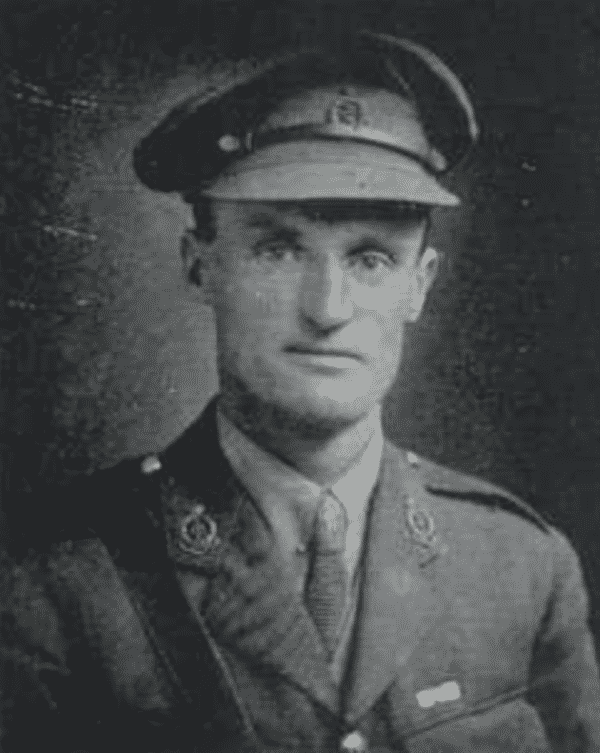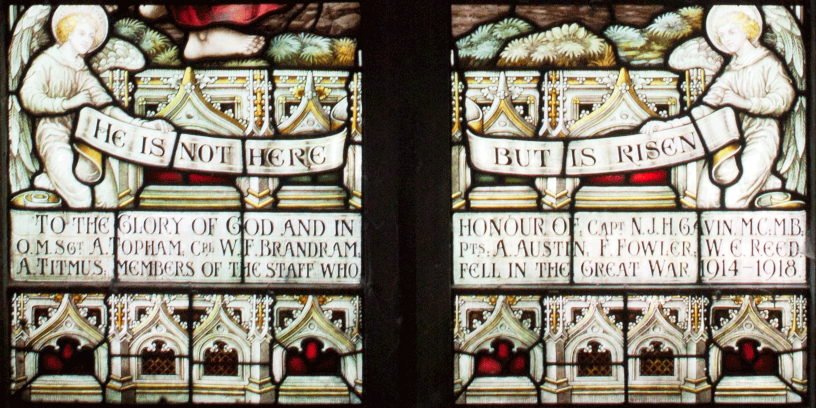A couple of years ago we published a picture of the memorial window in St Luke’s chapel, which is currently undergoing conversion to four luxury residential units. Memorialised in that window are seven men connected with the Three Counties Asylum who gave their lives in the Great War – and ahead of Fairfield’s Remembrance Service today, we are sharing the story of one of them.

The first man on the list – a mark of his seniority both within the asylum and within the armed forces, is Captain NJH Gavin. As a qualified doctor he is fairly easy to trace through medical directories. He first appears in the Medical Student Registers in 1900, which show that he has undertaken preliminary study in New Zealand, commencing on 10 April 1899 at the University of Otago, before moving to the University of Edinburgh to complete his medical degree.
We know a little more about Gavin’s connections to New Zealand and Scotland thanks to John Stevenson, his second cousin twice removed, who has researched the family tree and collected a large amount of information, including the picture above. He told me: “Our connection is through Archibald Clark. His daughter married James Young Stevenson – both families emigrated to New Zealand in the 1850s from Scotland. James Clark Gavin married Elizabeth Hay and they had seven children. Noel was born in 1880 and attended the Whanganui Collegiate School. He went on to study medicine at Edinburgh University.”
After being awarded his medical degree in 1904, Dr NJH Gavin appears in the UK and Ireland Medical Registers, which are published annually. Tracing him through those snapshots, we can see that he stays in Edinburgh until 1906, then works as Assistant Medical Officer at the Norfolk County Asylum between 1907 and 1909, moving to the West Riding Asylum near Leeds from 1910 to 1915 and finally the Three Counties Asylum in 1916 and 1917 – although another directory suggests that he may have been linked to the Three Counties Asylum as early as 1914.
The focus on mental health is clear from the medical directories, but we also know from John Stevenson’s research that Gavin reports being awarded a scholarship at Manchester in 1908 for Research in Lunacy. “His idea is to work at the pathological side of mental diseases, with a view to discovering the causes at work in producing insanity.” However, his work is interrupted by the war.
Military Records show that Noel John Hay Gavin is affiliated to both the Royal Army Medical Corps and the Irish Rifles. It’s not clear exactly when he goes to the front, but Whanganui Collegiate School publishes Old Boys’ News, which reports that he joins the Royal Army Medical Corps in August 1915 and is awarded the Military Cross soon afterwards.
A gazette from 18 October 1917 then reports that Temporary Captain NJH Gavin has been awarded the Bar to the Military Cross “For conspicuous gallantry and devotion to duty. He worked unceasingly for many hours at night dressing the wounded. When the Medical Officer sent to assist him was killed and the aid post was wrecked by shell fire, he continued his work of tending the wounded in the trenches and the open until relieved, although slightly wounded. He carried out his duties regardless of personal danger.”
Less than a month later, he is killed at the front in an incident that is recorded as ‘accidental death’. His obituary from Old Boys’ News again fills in the blanks:
“NOEL JOHN HAY GAVIN, R.A.M.C., M.C. and Bar, Major in the 14th Royal Irish Rifles, died in France on Nov 1st 1917 as the result of an accident while riding up to the trenches at night along a wooden road. His horse took fright, bolted, slipped and fell, throwing Captain Gavin on his head and inflicting such serious injuries that he died shortly after reaching the casualty clearing station. He was buried the following day in the local cemetery.”
There is slight disagreement about the date: Gavin’s military and probate records have it as 2 November 1917 – but that discrepancy could just be the difference between the time of the accident and the official time of death.
In addition to Captain Gavin’s mention in our memorial window in Fairfield, there is a plaque in his memory in the chapel at Whanganui Collegiate School and he is also listed on the old boys’ roll of honour there.
We hope to fill in the blanks about several of the other men listed in the St Luke’s memorial window over the coming months. Follow us to be first to see those updates!
